实用阶梯英语跨文化交际 (1)
- 格式:ppt
- 大小:2.16 MB
- 文档页数:35

跨文化交际第四版实用阶梯英语笔记【导言】跨文化交际是当今全球化背景下至关重要的技能之一。
与他人进行跨文化交际,需要我们具备一定的英语能力,同时也需要了解不同的文化习俗和传统。
在这方面,跨文化交际第四版实用阶梯英语笔记给了我们很好的指导和帮助。
本文将深入探讨这一主题,帮助读者更好地理解和应用跨文化交际的相关知识。
【正文】一、跨文化交际的重要性跨文化交际是指不同文化背景下的人们进行交流、合作和互动。
在全球化的今天,跨文化交际变得越来越重要,因为我们经常需要与不同文化背景的人打交道。
而跨文化交际第四版实用阶梯英语笔记对于我们学习和提升跨文化交际能力是非常有益的。
二、跨文化交际第四版实用阶梯英语笔记的特点跨文化交际第四版实用阶梯英语笔记是一部系统介绍英语交际和跨文化沟通的教材。
它通过实用性的案例和知识点,帮助学习者更好地理解和应用英语,同时也关注了不同文化之间的交际技巧和原则。
在笔记中,作者结合了大量的跨文化交际案例和经验,使得学习者能够更加深刻地理解跨文化交际的重要性和技巧。
三、如何有效利用跨文化交际第四版实用阶梯英语笔记在使用跨文化交际第四版实用阶梯英语笔记时,我们可以从以下几个方面进行学习和应用:1. 学习常见的交际技巧和原则:跨文化交际需要我们了解对方文化的基本礼貌和行为规范。
通过学习笔记中的案例和技巧,我们可以更加深入地了解不同文化之间的交际技巧,避免造成不必要的误会和冲突。
2. 加强英语口语和书面表达能力:跨文化交际需要我们具备一定的英语表达能力。
跨文化交际第四版实用阶梯英语笔记通过大量的练习和案例,帮助我们提升英语口语和书面表达能力,使得我们能够更加自如地与他人交流。
3. 建立跨文化交际的意识和能力:跨文化交际不仅仅是语言交流,更重要的是文化之间的理解和尊重。
在使用跨文化交际第四版实用阶梯英语笔记时,我们需要培养跨文化交际的意识和能力,学会在交流中尊重对方的文化差异,避免产生不必要的文化冲突。
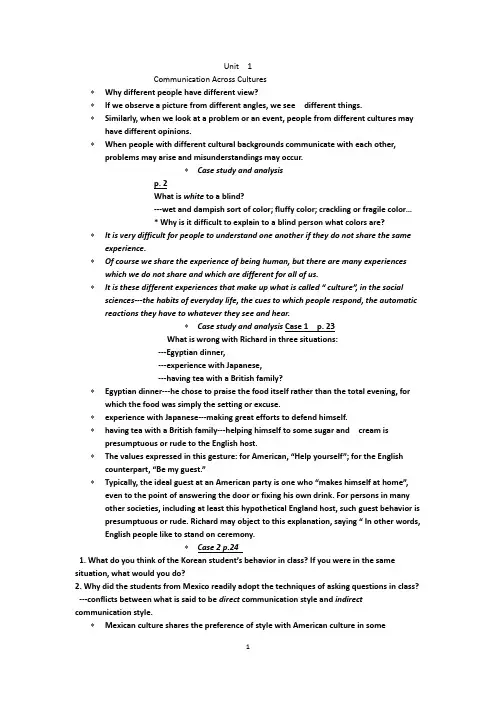
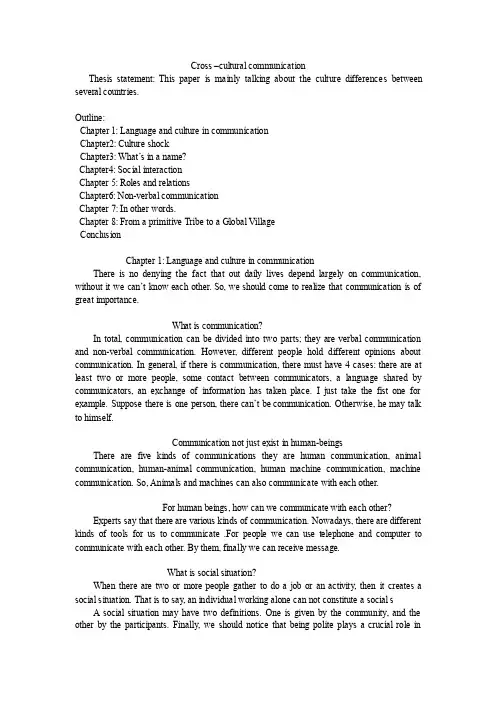
Cross –cultural communicationThesis statement: This paper is mainly talking about the culture differences between several countries.Outline:Chapter 1: Language and culture in communicationChapter2: Culture shockChapter3: What’s in a name?Chapter4: Social interactionChapter 5: Roles and relationsChapter6: Non-verbal communicationChapter 7: In other words.Chapter 8: From a primitive Tribe to a Global VillageConclusionChapter 1: Language and culture in communicationThere is no denying the fact that out daily lives depend largely on communication, without it we can’t know each other. So, we should come to realize that communication is of great importance.What is communication?In total, communication can be divided into two parts; they are verbal communication and non-verbal communication. However, different people hold different opinions about communication. In general, if there is communication, there must have 4 cases: there are at least two or more people, some contact between communicators, a language shared by communicators, an exchange of information has taken place. I just take the fist one for example. Suppose there is one person, there can’t be communication. Otherwise, he may talk to himself.Communication not just exist in human-beingsThere are five kinds of communications they are human communication, animal communication, human-animal communication, human machine communication, machine communication. So, Animals and machines can also communicate with each other.For human beings, how can we communicate with each other?Experts say that there are various kinds of communication. Nowadays, there are different kinds of tools for us to communicate .For people we can use telephone and computer to communicate with each other. By them, finally we can receive message.What is social situation?When there are two or more people gather to do a job or an activity, then it creates a social situation. That is to say, an individual working alone can not constitute a social sA social situation may have two definitions. One is given by the community, and the other by the participants. Finally, we should notice that being polite plays a crucial role insocial situation.Chapter2: Culture shockWe should not only know what communication is but we should know what culture shock is.In contemporary society, as our country is developing faster and faster, more and more foreigners will come to our country. Communicating with foreigners is an interesting thing. However, there is no doubt that it can easily cause misunderstanding which is called culture shock. There are several kinds of culture shock.Hospitality: First of all, in Britain, hospitality can not be judged by whether hosts put the food into your dishes, in there, everyone has own dishes, everyone helps themselves. By contrast, in our country, when we have guests, hosts may put the food into guest’s dishes to show their hospitality, so this is different.Politeness: When it comes to this word, in many case, foreigners were described as being polite than Chinese. For example, when we finish work, foreigners may say thank you to us, although it is out duties. However, for Chinese, they seldom say thank you because they think someone who serves them are their duties.What’s more, when we get along with foreigners, we should avoid asking their salaries, jobs and religious and so on. For the young, it’s all right to ask their ages, for the adults, this question is not allowed, especially for the females. But in china, these questions are allowed.In conclusion, when we face these culture shocks, it is better to keep a cool head, and then make an adjustment toward it, finally, we can cope with it. As time goes by, we can adapt it. For example, American Jewish and Israel, the two groups are equal and integration. Both groups have positive attitudes toward one another. So I am sure that after learning this unit, we can know a lot about culture shock and can easily communicate with foreigners.Chapter 3: What’s in a name?The topic of unit three is “what’s in a name?” As is known to all, the English name is different from the Chinese name .The Chinese name consists of family name and given name ,with family name put first. But in contrast, the family name of English name is coming last. Most English people have three names. The last name , or surname is the family name .This is the family name of the father and is given to all his children. And the first name is given to the child at birth, which is called “given name”. And another name used to refer to them is Christian name.However, Chinese name can give all sorts of information about a Chinese people .they may give the address, the birthday ,and also tell us about the family relationship, ethic groups, sex and the parents’expectation for their children. At the same time, in Chinese the use of kin terms is closely related to age politeness, such as that children are expected to call an old lady, Granny and call a male adult who is older than their fathers, elder uncle. The appropriate and extend use of kin term according to age is taken as reflecting good manners.Chapter4: Social interactionWhat is “social interaction”. It is the topic of unit four. Social interaction is an important way of human existence, and it is different from other animals’communication. And it’s meaningful. Different countries have different social interactions. Many Chinese people tend to ask age, marital status, and evensalary when they meet each other first. To the Chinese people, these are open conversational topic. and Chinese people pay much attention to family life. So in their spare time, they will talk about the family member features as a common topic. It is so natural. And the salary is not a secret .and when a Chinese offers refreshments or drinks to his colleague, his colleague often declines the offer politely, because he don’t want to trouble the person who offers. And it also shows his politeness. But in western countries, if you ask the person who meet you first about these, they will feel so bad. They think it is not polite.Do you know how English native negotiate a time to meet .from the text I know that you may find their way of settling on a time is quite similar to our own, that is , normally one gives or suggests a time, then the other may find it is not suitable and suggest another time, and finally a time is fixed which suits both.Consequently, you can know from above, different countries have different habits.Chapter 7: In other words.Different languages cause some misunderstandings There are many countries that their language is the same. such as America , British, Canada, Australia,and so on, they all speak English, people from America and British speak different varieties of English. They usually find little difficulty in understanding each other. However, there are some differences which may cause some misunderstanding, because of profusion of synonyms that they use different words to refer to the same thing. But for other countries which do not speak English they hardly understand the idioms, for example “face the music” in America it means to accept the criticisms, unpleasant consequences, etc . it probably comes from the custom in some Western armies of punishing soldiers to the sound of beating drums, if a person who is come from China may comprehend that enjoy himself by listening to music. on the contrary,they can not understand the meaning of Chinese idioms.There are some similar in languagesWith the exception, both English and Chinese have many such idioms that refer to animals, and some animals have similar associations in both cultures: deer, for example , are bloodthirsty and cruel, ect . But some other animals have rather different associations, like dogs, in the eyes of English-speaking people,dog is loyal ,but in the eyes of Chinese it aways contains derogatory sense are seen rather differently from the way appear to us. About proverb, since human experiences and observations of the world are in many respect similar. in spit of the dissimilar cultural backgrounds of the Chinese and the English-speaking peoples, the number of proverbs or saying in two language that are equivalent or closely approximate is rather surprising.Swearwords is the taboo for every countriesEvery language contains a special group of taboo words which people avoid using because they find them embarrassing or offensive. In many languages, swearwords are taboo, this is generally true of both English and Chinese. In English, certain swearwords seem to be more offensive than others and consequently the social prohibition against their use is stricter.Chapter 8: From a primitive Tribe to a Global VillageAnimals might have astonishing ways of showing their emotions andfeelings.This unit takes us back in to history, inviting us to reflect upon how man has extended his limbs and senses by using new technologies. Nowadays, the technologies are so advanced that communication over long distance can be done in a split of a second. People all over the world are living, quite literally, in a global village. In the textbook, we have learned that animals might have astonishing ways of showing their emotions and feelings. The way different kinds of animals behave, have fascinated great minds since Plato and AristotleCommunication is covering everywhereOne point that is beyond doubt is that our ancestors were extremely handicapped --- in comparison with us now --- in communication. From the Stone Age, to the present day, over 2,000,000 years, man has done his best to extend himself in order to improve his way of communication. Writing, printing technology, postal services, telegraph, telephone, radio, picture communication, television, computer and laser technology, internet --- these have ex tended man’s mouth, eyes, ears, hands, legs, in short the whole body beyond a house, a village, a county, a province, a country, an ocean, a continent, and even beyond the mother earth to the moon and the Mars. Going global is great, but an entirely different tone was heard: Globalization is a menace to mankind. Globalization will make the powers more powerful but the weak is weaker and the poor is poorer.ConclusionDifferent countries have their own cultures, so it causes the different cultures .Consequently, sometimes the people come from different places may cause some misunderstandings. After learning this textbook we can get along well with people all over the world.Finally, through this paper, we can learn more knowledge.。
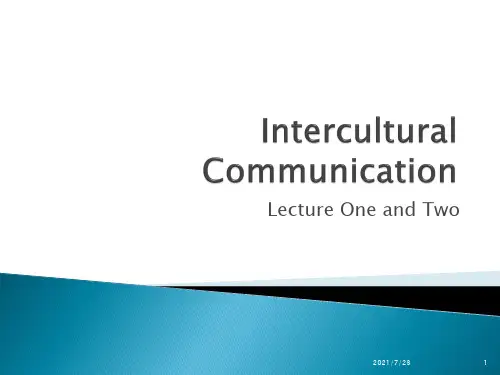
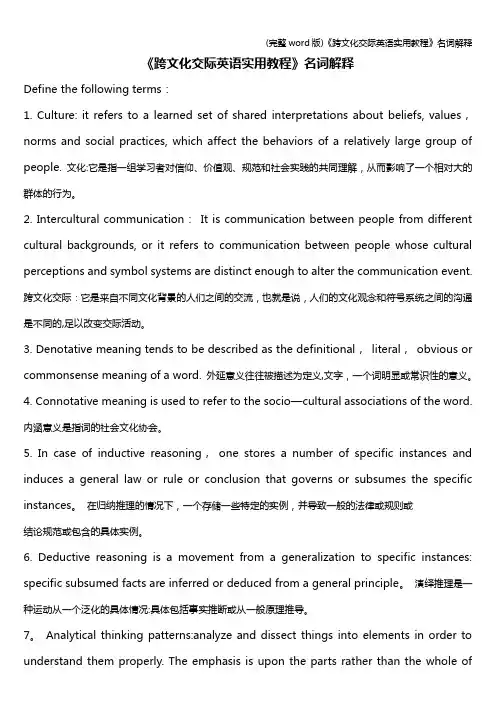
《跨文化交际英语实用教程》名词解释Define the following terms:1. Culture: it refers to a learned set of shared interpretations about beliefs, values,norms and social practices, which affect the behaviors of a relatively large group of people.文化:它是指一组学习者对信仰、价值观、规范和社会实践的共同理解,从而影响了一个相对大的群体的行为。
2. Intercultural communication:It is communication between people from different cultural backgrounds, or it refers to communication between people whose cultural perceptions and symbol systems are distinct enough to alter the communication event.跨文化交际:它是来自不同文化背景的人们之间的交流,也就是说,人们的文化观念和符号系统之间的沟通是不同的,足以改变交际活动。
3. Denotative meaning tends to be described as the definitional,literal,obvious or commonsense meaning of a word.外延意义往往被描述为定义,文字,一个词明显或常识性的意义。
4. Connotative meaning is used to refer to the socio—cultural associations of the word.内涵意义是指词的社会文化协会。

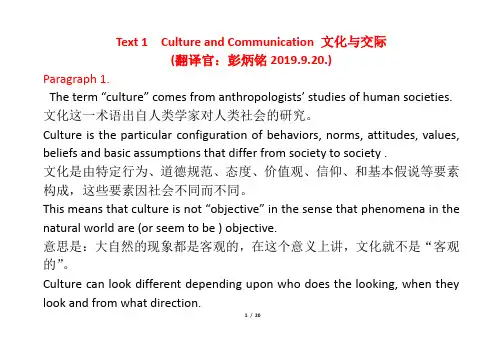
Text 1 Culture and Communication 文化与交际(翻译官:彭炳铭2019.9.20.)Paragraph 1.The term “culture” comes from anthropologists’ studies of human societies. 文化这一术语出自人类学家对人类社会的研究。
Culture is the particular configuration of behaviors, norms, attitudes, values, beliefs and basic assumptions that differ from society to society .文化是由特定行为、道德规范、态度、价值观、信仰、和基本假说等要素构成,这些要素因社会不同而不同。
This means that culture is not “objective” in the sense that phenomena in the natural world are (or seem to be ) objective.意思是:大自然的现象都是客观的,在这个意义上讲,文化就不是“客观的”。
Culture can look different depending upon who does the looking, when they look and from what direction.1/ 20文化看起来是不同的,这有赖于谁在看、何时看、从什么方向(角度)来看。
This makes culture difficult to grasp. 这就使得文化很难掌握。
Paragraph 2.Culture has been defined in many ways but a classic definition is : 文化的定义是多方面的,但有一个经典的定义是:Culture consists of patterns, explicit and implicit, of and for behavior, acquired and transmitted by symbols, constituting the distinctive achievements of human groups … the essential core of culture consists of traditional ideas and especially their attached values.”【译文】文化包含各种外显和内隐的行为模式,这些行为模式通过符号习得和传播,构成了人类群体与众不同的成就。
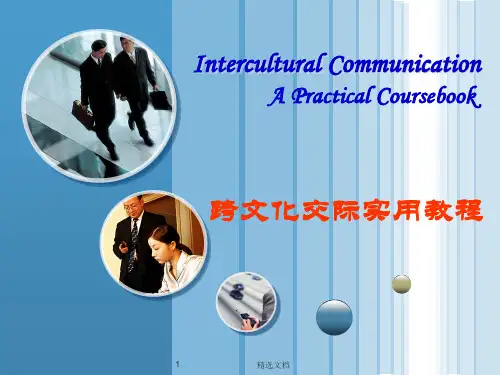

The differences in body language between China and the United Stateslike verbal language, is also a part of culture .Different culture shavedifferent body languages except some world known ones. And in inter cultural communication, the same body language may mean different things.There I will introduce some basic examples, emphasizes the significance of body languages in interculturalcommunication by comparing the body la nguages in the United States and China.Ⅰ.Action is the same, Meaning is different⑴Index finger banging on the templesChinese meaning:Said people are trying to think, meditate.American meaning:Said the man crazy, spirit is not normal.⑵Prick up middlMiddle finger upChinese meaning: Don't have any special meaning.e fingerAmerican meaning: Is a very rude behavior⑶Make a fistChinese meaning: Show power or to try to do something.American meaning:Said Angry⑷Stamping feetChinese meaning: Angry; Angry; Lose heart; regretAmerican meaning: ImpatientⅡ. Meaning is the same, Action is different⑴Come hereChina's body language: Reach out to called people,and Palm down, a few fingers bend several times at the same time.Body language in the u.s. : To called people, palm up, clench fist with the index finger back and forth. (Chinese antipathy to this).⑵"A shame" ,“unabashed” (a joke)China's body language: Stretched out index finger, with your fingertips on his face a few strokes, like itching, but the fingers are straight Body language in the u.s. : Stretched out his hands index finger, palms down, wipe with a forefinger index finger on the back of another.⑶"I'm full." (after dinner)China's body language: With one hand or both hands gently patted his belly Body language in the u.s. : Place one hand on your throat, palms down, often say "here" at the same time.Not all of the examples here, but can explain the difference of body language, also understand the importance of body language in another language. In a sense, all body language should be put in specific situations to understand, otherwise,Ignoring the whole situation will happen misunderstanding.。


1. Communication is a dynamic, systematic process in which meanings are created and reflected in human interaction with symbols.2.Culture : The deposit of knowledge, experience, beliefs, values, actions, attitudes, meanings, hierarchies,religion, notions of time, roles, spatial relations, concepts of universe, and artifacts acquired by a group of people in the course of generations through individual and group striving.3.Acculturations: occurs when a society undergoes drastic culture change under the influence of a moredominant culture and society with which it has come in contact.4. Intercultural communication: It is communication between people whose cultural perceptions and symbolsare distinct enough to alter the communication event.5.co-culture: when talking about groups or social communities exhibiting communication characteristics,perceptions, values, beliefs, and practices that are significantly different enough to distinguish them from the other groups, communities, and the dominant culture.nguage is an organized, generally agreed on, learned symbol system used to represent theexperiences within a cultural community.7.Perception : the process by which an individual selects, organizes, and information to create a meaningfulpicture of the world.8.Value : is an enduring belief that a specific mode of conduct or end-state of existence is personallyor socially preferable to another.9. Culture patterns : refers to both the conditions that contribute to the way in which a people perceiveand think about the world, and the manner in which they live that world.10.Collectivism: is characterized by a rigid social framework that distinguishes between in-groups and out-groups.11.Masculinity: is the extent to which the dominant values in a society are male oriented and associatedwith ambitions, differentiated sex roles, achievements, acquisition of money and signs of manliness.12. A high-context (HC) communication or message is one in which most of the information is either inthe physical context or internalized in the person, while very little is in the coded, explicit, transmitted part of the massage. A low-context (LC) communication is just the opposite; i.e., the mass of information is vested in the explicit code.13.Context: the information that surrounds an event; it is inextricably bound up with the meaning of thatevent.14. World view is a culture ’s orientation toward God, humanity, nature, questions of existence, the universeand cosmos, life, moral and ethical reasoning, suffering, death, and other philosophical issues thatinfluence how its members perceive their world.15.Argot is a more or less private vocabulary peculiar to a co-cultural group, and a group must have anargot if it is to be considered a co-culture.16.Nonverbal communication involves all those nonverbal stimuli in a communication setting that aregenerated by both the source and his or her use of the environment and that have potential message value for the source or receiver.17.A learning style is a particular way that an individual receives and processes information.18.Stereotyping is a complex form of categorization that mentally organizes our experiences and guidesour behavior toward a group of people.19.Culture shock: when we are thrust into another culture and experience psychological and physicaldiscomfort from this contact we have become victims of culture shock.20.Ethnocentrism:the belief that one ’s culture is primary to all explanations of reality.21.Seven characteristics of culture affect communication: learned, transmitted from generation to generation,based on symbols, dynamic, integrated, ethnocentric, adaptive.22.Belief: our conviction in the truth of something. Learned and subject to cultural interpretation and culturaldiversity.23.Individualism: refers to the doctrine, spelled out in detail by the seventeenth. The single mostimportant pattern in the US.24. Hofstede s’Value Dimensions: four parts: individualism-collectivism, uncertainty avoidance, powerdistance, and masculinity and femininity.25.Culture differs in their attitudes toward: individualism and collectivism, uncertainty avoidance, powerdistance, masculinity and femininity, human nature, the perception of nature, time, activity, relationships, context, formality and informality, assertiveness and interpersonal harmony.26.Religious Similarities: sacred writings, authority, traditional rituals, speculation, ethics.27.Five religious orientations: Christianity, Judaism, Islam, Hinduism, Buddhism.28.the family we are born into the family of orientation and take a spouse the family of procreation.29.problems of translation and equivalence : vocabulary or lexical equivalence, idiomatic and slangequivalence,grammatical-syntactical equivalence,experiential-cultural equivalence,conceptual equivalence.30.The use of argot reflects a co-culture ’s need to have a language that permits them to 1.sharemembership,2. participate in their social and cultural communities,3. identify themselves and their place in the universe, 4. communicate with one another about their own social realities.31. Functions of communication:repeating, complementing, substituting, regulating, contradicting.32.The study of how movement communicates is called kinesics . Kinesic cues are those visible body shiftsand movements that can send messages about 1.our attitude toward the other person 2. ouremotional state 3. our desire to control our environment.33. Eyes serve six communication functions: 1. indicates degree of attentiveness, interest, and arousal 2.help intiate and sustain intimate relationships 3. influence attitude change and persuasion 4. regulate interaction 5. communicate emotions 6. define power and status relationships 7. assume a central role in impression management.34. kinds of vocalizations: vocal characterizers, vocal qualifiers, vocal segregates.。